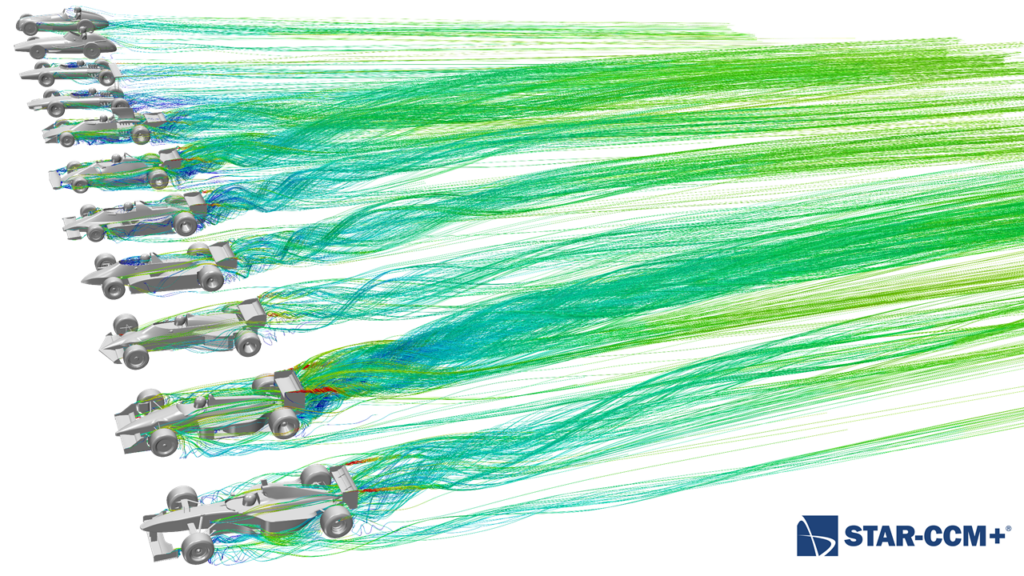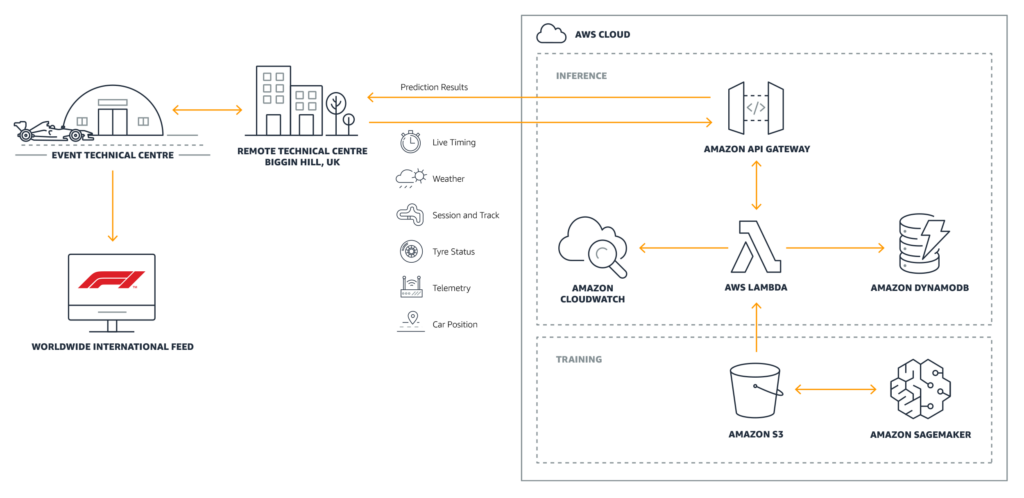Formula One Racing: Data-driven Drive to Survive

In 2018, F1 partnered with AWS to become its official cloud service and machine learning provider – a mutually beneficial relationship. AWS introduced initiatives to derive value from the big data collected by F1 teams to create more engaging viewer experiences.

FORMULA ONE RACING AT A GLANCE
Formula 1 Racing
Formula One (F1) racing is the world’s leading motorsport competition which pits 10 pinnacle teams against one another in more than 20 races. The sport is a perfect amalgamation of athletic talent, human ingenuity, and engineering precision, as teams strive to build the best racing cars, within restrictive F1 regulations, that perfectly match their specific driver’s unique abilities and driving style.
History of Data Analytics in Formula 1
From the early days, leveraging insights from data analytics has been critical to competing effectively in F1, which has forced the sport to be increasingly data-driven and technology-centric.
As the speed of F1 cars increased over time from their roots in 1950, understanding the effects of aerodynamics on performance became increasingly important. Empirical methods such as wind tunnel testing were initially adequate, but they failed to enable engineers to understand the infinitesimal details necessary to unlock additional performance. Computational Fluid Dynamics (CFD) enabled F1 engineering teams to model aerodynamics, which lead to big leaps in F1 car design.

LEVERAGING BIG DATA ANALYSIS AND MACHINE LEARNING FOR RESEARCH & DEVELOPMENT
Big Data and Machine Learning in Formula 1
Leveraging computational simulations and data analysis to inform race car design worked well during development, but race engineers also required solutions that could model performance in real-time to gain insights that could inform critical decision-making during races. Decisions such as when to pit, which tires to fit based on temperature, and precipitation are critical to winning a race. Most F1 cars finish within milliseconds of one another, so unlocking thousandths of a second of performance can maximize a team’s chances of winning.
A modern F1 car is fitted with approximately 300 sensors, which stream a total of 1.1 million data points per second to their respective racing teams in real time. The advent of machine learning and big data analysis have enabled race engineers to not only derive value from this large stream of real-time data, but also combine it with more than 70 years of historical data.

Formula One Team Technology Partnerships
By the early 2000s, F1 teams had realized the benefits of incorporating big data, data analytics, and machine learning into their R&D and race management. Most F1 teams had individual partnerships and sponsorships with large technology firms that offered technical capabilities and infrastructure to strengthen their data analytics pipelines, and processing. Leading technology companies like Amazon Web Services (AWS), Google, AMD, Cognizant, Dell Technologies, and Oracle sponsor either the F1 organization or specific F1 teams.

The trend of technology partnerships in F1 has increased over time, bringing more lucrative and mutually beneficial funding sources to teams, while also improving the overall sentiment around F1 advertising, which was previously dominated by questionable sponsors like tobacco brands, who didn’t appeal to millennial, middle-class and technology savvy audiences.
LEVERAGING DATA-DRIVEN INSIGHTS TO IMPROVE FAN EXPERIENCES AND ENGAGEMENT
In 2018, F1 partnered with AWS to become its official cloud service and machine learning provider – a mutually beneficial relationship. AWS introduced initiatives to derive value from the big data collected by F1 teams to create more engaging viewer experiences.

Cloud-based CFD Analysis: In 2022, F1 implemented race car design regulations to decrease the negative effects of racing in close proximity to make races more competitive and engaging for the fans. Leading up to this, F1 took the lead on R&D to gather technical evidence to ground these new regulations – critical to getting buy-in from F1 engineering teams. F1 partnered with AWS to use their High-Performance Compute Services to perform complex aerodynamic simulations 70% faster than what was previously possible.
F1 Racing Insights: After partnering with AWS, F1 decided to unravel the data behind the racing. Up until this point, fans only witnessed race engineers staring at walls plastered with monitors showing overlayed graphs. By leveraging AWS’ SageMaker tools, F1 built machine learning models which provided fans with real-time insights on race strategy, competitor analysis, and car performance which increased engagement, and allowed F1 to extract increased revenue by offering data-focused insights through F1TVPro.




WHAT DOES THE FUTURE LOOK LIKE?
While leaning into technology initiatives has enabled the F1 community to revive itself and attract younger and diverse audiences, some backlash has risen against the transparency-focused initiatives that F1 has introduced. For example, some criticized the introduction of the AWS F1 insights since they believed that it removed the allure of the sport by unraveling the complex decision-making. Furthermore, some believe that these insights also influence competition between teams who have increasingly found themselves in controversial disagreements off the track. Despite the new audience that F1’s “Drive to Survive” Netflix show attracts, some fans and internal stakeholders believe that exposing the data, discourse, and drama behind-the-scenes risks tarnishing the enigma of the sport further. These issues peaked during the final Grand Prix race in 2021, where a controversial race decision was publicly debated, protested, and implemented, resulting in a championship win that is still in contention amongst fans today. As a result of the backlash, F1 pulled back on some of its initiatives to make the inner workings of the sport more transparent to manage (read: “censor”) what is shared publicly. Moving forward, F1 will need to tread carefully around how to leverage its data-driven DNA, and there’s no doubt that “data” will help solve F1’s need to survive and thrive.
RESOURCES
https://dev.to/aws-builders/how-formula-1-insights-are-powered-by-aws-3ndb
https://en.wikipedia.org/wiki/Formula_One
https://www.formula1.com/en/toolbar/partners.html
https://blogs.sw.siemens.com/simcenter/a-cfd-story-the-brief-history-of-formula-one-aerodynamics/
https://www.racecar-engineering.com/advertisement/fluid-dynamics-in-motorsport/



I love this post! Thanks a lot Nthato for posting about F1!
Coming from a mechanical engineering and automotive background, I’ve seen first hand the importance of CFD when it comes to drag, performance and decision making on even coatings that goes into many of the components. The importance of those measurements grow 10x or even 100x when it comes to competition such as the F1 where split second decisions taken will change the outcomes drastically. It’s so fascinating to see how many reengineering iterations happens in an F1 season these days thanks to the data that’s created by these hundreds of sensors
I remember reading about Mercedes Benz team and the terabytes of data that they generate on a daily basis and how they were able to reduce the computational time required to make better decisions. At the same time, it reminds me of the TSG Hoffenheim case on what do you do when data becomes not a competitive advantage and other players are slowing closing the gap?
Thanks for sharing Nthato. As a former mechanical engineer, I appreciate the use of technology to further push the engineering excellence in Formula 1. While they partnered with the F1 organization for the racing insights, I wonder why they decided to limit their computing capabilities for CFD analysis only to change the design regulations (versus being a tool that R&D engineering teams can use to improve their own design). Also, I would love to hear more about your take as a fan of the AWS F1 insights on the sport (which you mentioned are now being censored) — I think that those cars fully loaded with sensors and the ability to process real-time data in the cloud would make an interesting new layer of fan engagement (like a premium service for an inside view of your team race-time decisions and the effects on a digital twin of the asset in the race).